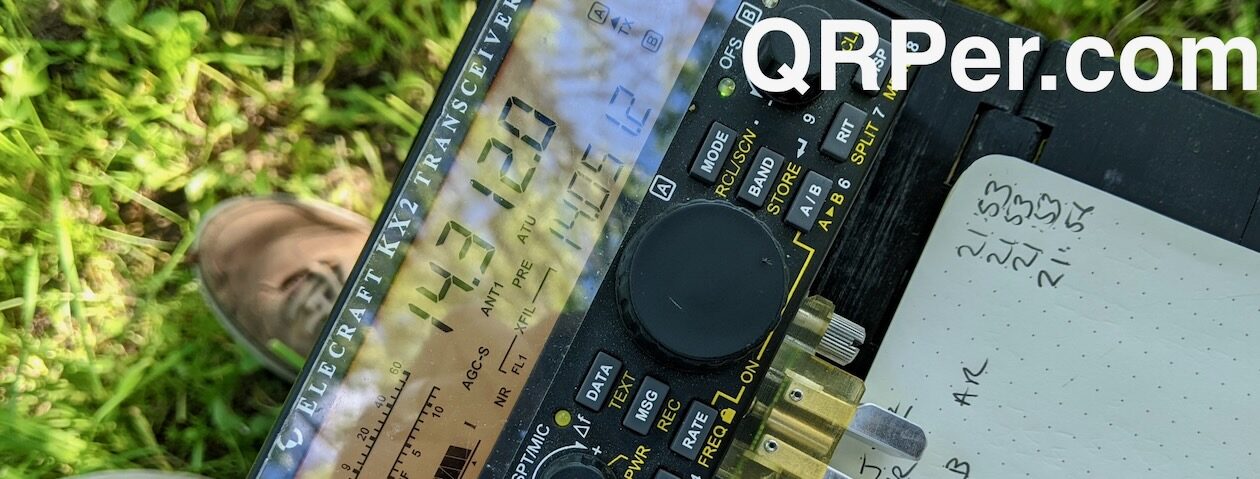by Thomas (DM1TBE)
Intro
The day after my activation of Park Babelsberg, I wanted to activate a second new POTA park. The new Park Sacrow is a picturesque park located on the River Havel in Potsdam, about which I have written a brief summary in the QRPer activation report for Park Babelsberg.
One of the prominent landmarks in the Park Sacrow is the Heilandskirche, also known as the Church of the Redeemer.
This neo-Romanesque church, completed in 1844, is a striking sight with its red brick façade, white stone accents, and tall tower. The Heilandskirche is overlooking the Havel River and offers panoramic views of the surrounding park and river.
During the time of the Berlin Wall, the Heilandskirche in Sacrow was located near the border between East and West Germany. The church was in the “No Man’s Land”, i.e. behind all East German border barricades – see photo from 1972 below with the Berlin Wall – preventing anyone from visiting.

After the years of decay, when the bad condition became too obvious from the West Berlin side, citizens of West Berlin tried to stop the further decay. After long negotiations between church authorities and the government of East Germany, the exterior of the church building was restored in 1984/85. Today, the church looks as beautiful inside as it looks outside.
With the border between East and West at the middle of the river, the whole area was a kind of border protection zone, only available to locals or those with a special permit.
The park is close to the Glienicker Bridge, also known as the “Bridge of Spies” from Steven Spielberg’s blockbuster, on the opposite of my position the day before.

As mentioned in my previous report, I have grown up less than a mile away from this famous bridge, in Potsdam, i.e. Soviet controlled part of Germany.
In my opinion, Steven Spielberg told the wrong story. There is another, more interesting story related to this bridge. It is the story of the Military liaison missions. A few British, US and French army members were allowed to roam freely in the Soviet controlled part of Germany and, vice versa, a few Soviets in West-Germany. These members of the military liaison missions had immunity from all German authorities. Since East Germany was frontline to the western world, the Soviet army had their most advanced technology there and the mission members’ task was it to spy, for example with this US Military Liaison Mission vehicle – note the license plate.

The uniformed, but unarmed mission members drove military-green cars with a special license plates – here a British mission car on display in a museum. For me as a child, those cars looked like from another planet.

The Glienicker Bridge border crossing wasn’t open for public, but only for those mission members and diplomats. The French and British mission houses were close to this bridge in the Soviet controlled part, the one for the US was some miles away.
French Mission House today:
British Mission House today:
Just imagine these two buildings with a huge British and French flag on top, in proximity to Soviet military installations behind the Iron Curtain.
It did not always go as smoothly as it could. The image below shows the Soviets handing over the corpse of Major Arthur D. Nicholson to the US authorities on the Glienicker Bridge. Nicholson was shot down in 1985 by a Soviet sentry at a Soviet army base in East Germany.

In 1984, Philippe Mariotti, a member of the French Mission Militaire Francaise de Liaison died after the East German Secret Service has set up a trap and rammed Mariotti’s car with an army truck.
The British BBC aired an interesting documentary about the British mission The British Commanders’-in-Chief Mission to the Soviet Forces in Germany (BRIXMIS) called “The Brixmis story”. If you find the topic interesting, there is a lot of stuff on YouTube when searching for Brixmis or USMLM.
The activation
The weather was significant better than the day before, with sun shining and warm spring temperatures. I also had more time available. Continue reading Another POTA activation close to the “Bridge of Spies”
















































